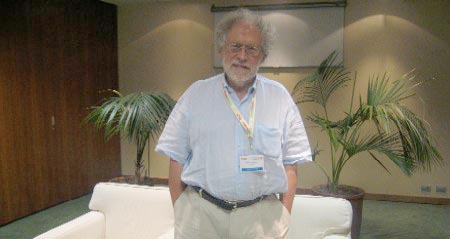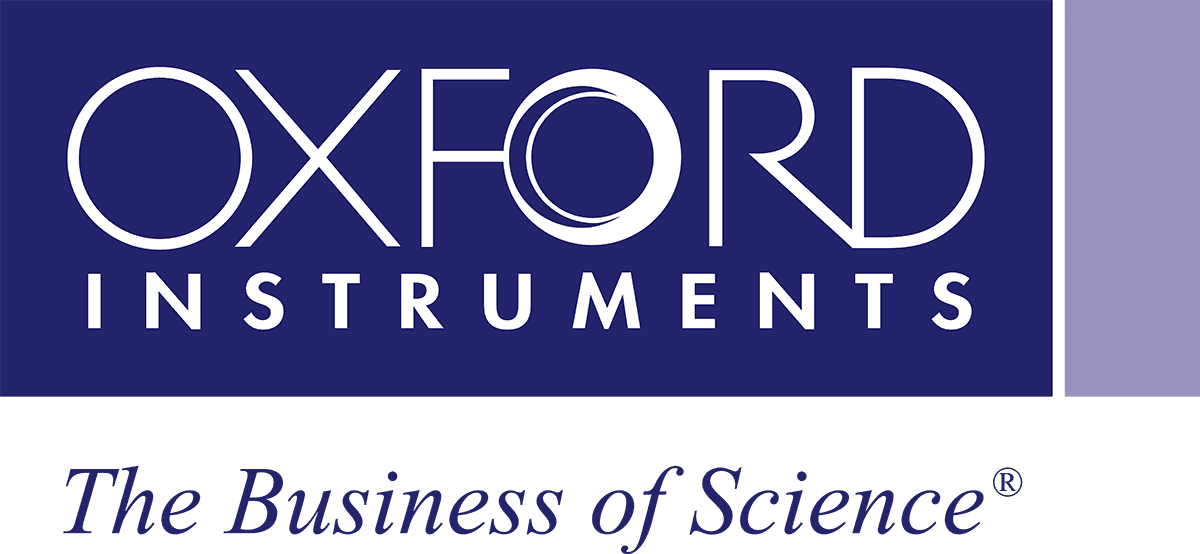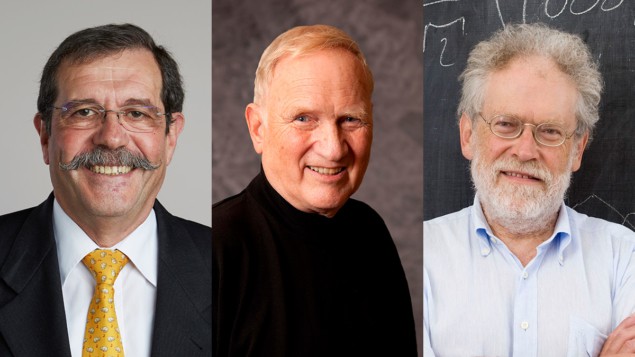Alain Aspect, John Clauser and Anton Zeilinger win the 2022 Nobel Prize for Physics
04 Oct 2022 Hamish Johnston
Winners of the 2022 Nobel Prize for Physics: Alain Aspect, John F Clauser and Anton Zeilinger. (CC BY-SA Royal Society; CC BY-SA John Clauser; CC BY-SA Austrian Academy of Sciences)
Alain Aspect, John Clauser and Anton Zeilinger have won the 2022 Nobel Prize for Physics. The trio won “for their experiments with entangled photons, establishing the violation of Bell’s inequalities and pioneering quantum information science”.
The prize will be presented in Stockholm in December and is worth 10 million kronor ($900,000). It will be shared equally between the winners.
Working independently, the three laureates did key experiments that established the quantum property of entanglement. This is a curious effect whereby two or more particles display much stronger correlations than are possible in classical physics. Entanglement plays an important role in quantum computers, which in principle could outperform conventional computers at some tasks.
Bell’s inequality
All three of the experiments measured violations of Bell’s inequality, which places a limit on the correlations that can be observed in a classical system. Such violations are an important prediction of quantum theory.
The first experiment was done in 1972 at the University of California at Berkeley by Clauser, who measured the correlations between the polarizations of pairs of photons that were created in an atomic transition. He showed that Bell’s inequality was violated – which meant that the photon pairs were entangled.
However, there were several shortcomings or “loopholes” in this experiment, making it inconclusive. It is possible, for example, that the photons detected were not a fair sample of all photons emitted by the source – which is the detection loophole. It is also possible that some aspects of the experiment that are thought to be independent were somehow causally connected – which is the locality loophole.
Ten years later, in 1982, Aspect and colleagues at the Université Paris-Sud in Orsay, France, improved on Clauser’s experiment by using a two-channel detection scheme. This avoided making assumptions about the photons that were detected. They also varied the orientation of the polarizing filters during their measurements. Again, they found that Bell’s inequality was violated.
Third loophole
The locality loophole was closed in 1998 by Zeilinger and colleagues at the University of Innsbruck in Austria. They used two fully independent quantum random-number generators to set the directions of the photon measurements. As a result, the direction along which the polarization of each photon was measured was decided at the last instant, such that no signal travelling slower than the speed of light would be able to transfer information to the other side before that photon was registered.
As well as confirming a fundamental prediction of quantum mechanics, the three experiments laid the groundwork for the development of modern quantum technologies.
Speaking at the press conference when the prize was announced, Zeilinger said he was “very surprised” to receive a call from the Nobel committee. “This prize is an encouragement to young people and the prize would not be possible without more than 100 young people who have worked with me over the years. I alone could not have achieved this.”
Zeilinger also said he hoped the prize would encourage young researchers.
“My advice to young people would be do what you find interesting and don’t care too much about possible applications. On the other hand, this recognition is very important for the future development of possible applications. I am curious what we will see in the next 10–20 years.”
A profound impact
Sheila Rowan, president of the Institute of Physics, which publishes Physics World, congratulated the trio on their “well-deserved” recognition. “This is an area of physics with ongoing, profound impact, at a fundamental level to help understand the world around us and being explored for use in highly novel technologies for sensing and communication today,” she added.
Quantum physicist Artur Ekert from the University of Oxford says that while he is “happy” to see the field and the trio being recognized with this year’s Nobel, he adds that it is a “pity” that John Bell, who formulated the inequalities, missed out given that he died in 1990 and Nobel prizes are not awarded posthumously.
Ekert adds that the advent of quantum cryptography has provided an additional motivation to push the Bell inequality experiments to their limits. “From the foundations of science perspective, I think the Bell inequality experiments simply had to be done — they refute a certain world view and so they are important,” adds Ekert. “Fixing all the loopholes in such experiments is another story. This is probably more important for the quantum cryptography perspective as if we want to use Bell inequalities to detect eavesdropping we have to close the loopholes.”
Indeed, congratulations also came from those who are trying to use the work of Aspect, Clauser and Zeilinger for practical applications. In a joint statement, Ilyas Khan and Tony Uttley, chief executive and president, respectively, of the quantum technology firm Quantinuum, noted they were thrilled” by the announcement.
“This recognition of the power of quantum information systems is timely on many counts, but above all is a wonderful acknowledgement of the fact that experimental advances underpin the quantum technologies revolution that we are embarking upon.”
A life in science
Aspect was born in Agen, France, on 15 June 1947. He passed the “agrégation” – the national French exam – in physics in 1969 and received his Master’s degree from the Université d’Orsay two years later. He then embarked on a PhD at Orsay, working on experimental tests of Bell’s inequalities, which he completed in 1983.
Following a lectureship at the Ecole Normale Supérieure de Cachan, which Aspect held while he was doing his PhD, in 1985 he worked at Collège de France in Paris. In 1992 he then moved to the Laboratoire Charles Fabry de l‟Institut d’Optique at the Université Paris-Saclay.
Clauser was born in Pasadena, California, on 1 December 1942. He received his Bachelor’s degree in physics from California Institute of Technology in 1964 and a Master’s in physics two years later. In 1969 he received a PhD in physics from Columbia University.
From 1969 to 1975 Clauser was a researcher at Lawrence Berkeley National Laboratory and from 1975 to 1986 worked at the Lawrence Livermore National Laboratory. Following a stint as a senior scientist at the US firm Science Applications International Corporation, in 1990 he moved to the University of California, Berkeley until 1997 where he then focused on his research and consultancy firm J F Clauser & Associates.READ MORE

Zeilinger was born in Ried im Innkreis, Austria, on 20 May 1945. In 1963 he began studying physics and mathematics at the University of Vienna and in 1971 completed his PhD in atomic physics. He then worked at the Atomic Institute in Vienna until 1983 before heading to the Vienna University of Technology.
In 1990 Zeilinger moved to the University of Innsbruck and in 1999 worked at the University of Vienna where he also became director of the Vienna-based Institute for Quantum Optics and Quantum Information from 2004 to 2013. In 2013 he served as president of the Austrian Academy of Sciences, a position he held until this year.Anton Zeilinger has written several articles for Physics World: “A quantum renaissance” by Markus Aspelmeyer and Anton Zeilinger; “Probing the limits of the quantum world” by Markus Arndt, Anton Zeilinger and Klaus Hornberger; and “Fundamentals of quantum information” by Anton Zeilinger.

Physics World‘s Nobel prize coverage is supported by Oxford Instruments Nanoscience, a leading supplier of research tools for the development of quantum technologies, advanced materials and nanoscale devices. Visit nanoscience.oxinst.com to find out more.

Hamish Johnston is an online editor of Physics World
FROM PHYSICSWORLD.COM 20/10/2022

Δεν υπάρχουν σχόλια:
Δημοσίευση σχολίου